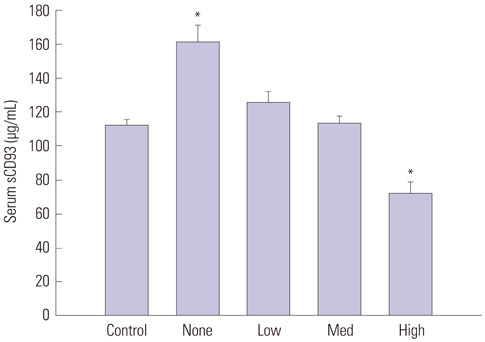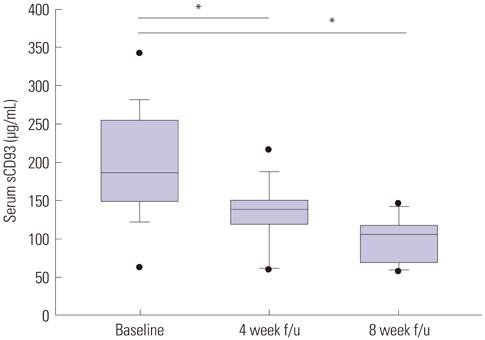Yonsei Med J.
2017 May;58(3):598-603. 10.3349/ymj.2017.58.3.598.
Soluble CD93 in Serum as a Marker of Allergic Inflammation
- Affiliations
-
- 1Department of Internal Medicine, Gangnam Severance Hospital, Yonsei University College of Medicine, Seoul, Korea.
- 2Institute of Allergy, Yonsei University College of Medicine, Seoul, Korea. jhleemd@yuhs.ac
- 3Division of Allergy and Immunology, Department of Internal Medicine, Yonsei University College of Medicine, Seoul, Korea.
- KMID: 2419118
- DOI: http://doi.org/10.3349/ymj.2017.58.3.598
Abstract
- PURPOSE
CD93 is receiving renewed attention as a biomarker of inflammation. We aimed to evaluate the potential for serum sCD93 to serve as a novel biomarker for allergic inflammation.
MATERIALS AND METHODS
We enrolled 348 subjects with an allergic disease [allergic rhinitis (AR), chronic spontaneous urticaria (CSU), or bronchial asthma (BA)], including 14 steroid-naïve BA patients who were serially followed-up.
RESULTS
The serum sCD93 levels (ng/mL) in patients with exacerbated AR (mean±standard deviation, 153.1±58.4) were significantly higher than in patients without AR (132.2±49.0) or with stable AR (122.3±42.1). Serum sCD93 levels in exacerbated CSU (169.5±42.8) were also significantly higher than those in non-CSU (132.4±51.6) and stable CSU (122.8±36.2). This trend was also seen in BA. Serum levels in patients with ICS-naïve BA (161.4±53.1) were significantly higher than those in healthy controls without BA (112.2±30.8), low- and medium-dose ICS users. Serum sCD93 levels in high-dose ICS users (72.2±20.6) were significantly lower than those in low- and medium-dose users. The serum sCD93 levels in steroid-naïve patients with BA (195.1±72.7) decreased after ICS use for 4 weeks (134.4±42.8) and 8 weeks (100.7±13.4), serially.
CONCLUSION
Elevated serum sCD93 levels reflected exacerbated status of allergic diseases, including CSU, AR, and asthma. ICS use significantly diminished serum sCD93 levels in steroid-naïve patients with BA. This result may suggest sCD93 in serum as a therapeutic marker for allergic inflammation.
Keyword
MeSH Terms
-
Adult
Asthma/*blood/diagnosis/immunology
Biomarkers/blood
Case-Control Studies
Chronic Disease
Cross-Sectional Studies
Female
Humans
Inflammation/blood/diagnosis
Membrane Glycoproteins/*blood/metabolism
Middle Aged
Receptors, Complement/*blood/metabolism
Rhinitis, Allergic/*blood/immunology
Urticaria/*blood/diagnosis/immunology
Young Adult
Biomarkers
Membrane Glycoproteins
Receptors, Complement
Figure
Reference
-
1. Paro-Heitor ML, Bussamra MH, Saraiva-Romanholo BM, Martins MA, Okay TS, Rodrigues JC. Exhaled nitric oxide for monitoring childhood asthma inflammation compared to sputum analysis, serum interleukins and pulmonary function. Pediatr Pulmonol. 2008; 43:134–141.
Article2. Haccuria A, Michils A, Michiels S, Van Muylem A. Exhaled nitric oxide: a biomarker integrating both lung function and airway inflammation changes. J Allergy Clin Immunol. 2014; 134:554–559.
Article3. Moore WC, Hastie AT, Li X, Li H, Busse WW, Jarjour NN, et al. Sputum neutrophil counts are associated with more severe asthma phenotypes using cluster analysis. J Allergy Clin Immunol. 2014; 133:1557–1563.
Article4. Bandyopadhyay A, Roy PP, Saha K, Chakraborty S, Jash D, Saha D. Usefulness of induced sputum eosinophil count to assess severity and treatment outcome in asthma patients. Lung India. 2013; 30:117–123.
Article5. Lee JH, Park KH, Park JW, Hong CS. YKL-40 in induced sputum after allergen bronchial provocation in atopic asthma. J Investig Allergol Clin Immunol. 2012; 22:501–507.6. Kwon HS, Kim TB, Lee YS, Jeong SH, Bae YJ, Moon KA, et al. Clusterin expression level correlates with increased oxidative stress in asthmatics. Ann Allergy Asthma Immunol. 2014; 112:217–221.
Article7. Greenlee MC, Sullivan SA, Bohlson SS. CD93 and related family members: their role in innate immunity. Curr Drug Targets. 2008; 9:130–138.
Article8. Nepomuceno RR, Henschen-Edman AH, Burgess WH, Tenner AJ. cDNA cloning and primary structure analysis of C1qR(P), the human C1q/MBL/SPA receptor that mediates enhanced phagocytosis in vitro. Immunity. 1997; 6:119–129.
Article9. Norsworthy PJ, Fossati-Jimack L, Cortes-Hernandez J, Taylor PR, Bygrave AE, Thompson RD, et al. Murine CD93 (C1qRp) contributes to the removal of apoptotic cells in vivo but is not required for C1q-mediated enhancement of phagocytosis. J Immunol. 2004; 172:3406–3414.
Article10. Greenlee-Wacker MC, Galvan MD, Bohlson SS. CD93: recent advances and implications in disease. Curr Drug Targets. 2012; 13:411–420.
Article11. Jeon JW, Jung JG, Shin EC, Choi HI, Kim HY, Cho ML, et al. Soluble CD93 induces differentiation of monocytes and enhances TLR responses. J Immunol. 2010; 185:4921–4927.
Article12. Moosig F, Fähndrich E, Knorr-Spahr A, Böttcher S, Ritgen M, Zeuner R, et al. C1qRP (CD93) expression on peripheral blood monocytes in patients with systemic lupus erythematosus. Rheumatol Int. 2006; 26:1109–1112.
Article13. Boulet LP, FitzGerald JM, Reddel HK. The revised 2014 GINA strategy report: opportunities for change. Curr Opin Pulm Med. 2015; 21:1–7.14. Bousquet J, Reid J, van Weel C, Baena Cagnani C, Canonica GW, Demoly P, et al. Allergic rhinitis management pocket reference 2008. Allergy. 2008; 63:990–996.
Article15. Bielory L, Meltzer EO, Nichols KK, Melton R, Thomas RK, Bartlett JD. An algorithm for the management of allergic conjunctivitis. Allergy Asthma Proc. 2013; 34:408–420.
Article16. Eichenfield LF, Tom WL, Chamlin SL, Feldman SR, Hanifin JM, Simpson EL, et al. Guidelines of care for the management of atopic dermatitis: section 1. Diagnosis and assessment of atopic dermatitis. J Am Acad Dermatol. 2014; 70:338–351.17. Zuberbier T, Aberer W, Asero R, Bindslev-Jensen C, Brzoza Z, Canonica GW, et al. The EAACI/GA(2) LEN/EDF/WAO Guideline for the definition, classification, diagnosis, and management of urticaria: the 2013 revision and update. Allergy. 2014; 69:868–887.
Article18. Bateman ED, Hurd SS, Barnes PJ, Bousquet J, Drazen JM, FitzGerald M, et al. Global strategy for asthma management and prevention: GINA executive summary. Eur Respir J. 2008; 31:143–178.
Article19. Greenlee-Wacker MC, Briseño C, Galvan M, Moriel G, Velázquez P, Bohlson SS. Membrane-associated CD93 regulates leukocyte migration and C1q-hemolytic activity during murine peritonitis. J Immunol. 2011; 187:3353–3361.
Article20. Mälarstig A, Silveira A, Wågsäter D, Öhrvik J, Bäcklund A, Samnegård A, et al. Plasma CD93 concentration is a potential novel biomarker for coronary artery disease. J Intern Med. 2011; 270:229–236.
Article21. Daino K, Ugolin N, Altmeyer-Morel S, Guilly MN, Chevillard S. Gene expression profiling of alpha-radiation-induced rat osteosarcomas: identification of dysregulated genes involved in radiation-induced tumorigenesis of bone. Int J Cancer. 2009; 125:612–620.
Article22. Baines KJ, Wood LG, Gibson PG. The nutrigenomics of asthma: molecular mechanisms of airway neutrophilia following dietary antioxidant withdrawal. OMICS. 2009; 13:355–365.
Article23. Sigari N, Jalili A, Mahdawi L, Ghaderi E, Shilan M. Soluble CD93 as a novel biomarker in asthma exacerbation. Allergy Asthma Immunol Res. 2016; 8:461–465.
Article
- Full Text Links
- Actions
-
Cited
- CITED
-
- Close
- Share
- Similar articles
-
- Soluble CD93 as a Novel Biomarker in Asthma Exacerbation
- Blood Level of Soluble CD30 and Soluble E-Selectin in Allergic Rhinitis Patients
- A comparison study on soluble FceR II/CD23 and IL-4 activities in the serum of children with allergic and non-allergic diseases
- Diagnostic Value of Eosinophil Cationic Protein (ECP) in Nasal Secretion of Allergic Rhinitis
- Soluble E-selectin as A Clinical Marker of Disease Activity in Atopic Dermatitis





